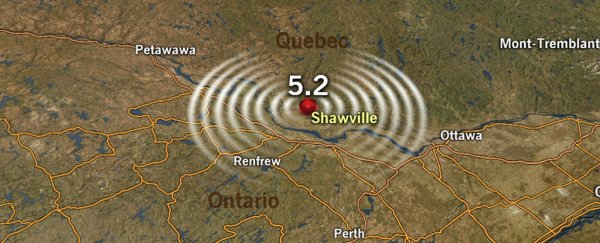Somewhere in Eastern Tennessee the ground seems to quiver ever so gently, only to swiftly pass and leave those who felt it to question if it even happened. Seismologists record it, noting once again – far from the boundary of any tectonic plate – the soft rumble of an earthquake where none should be.
Often quiet, occasionally devastating, these shakes are nearly always perplexing. Now geologists think they have some idea of what's causing them, and the answer lies deep beneath our feet.
As we learn in school, earthquakes are typically caused by the release of tension built up between the steady grind of Earth's tectonic plates.
But every year there are hundreds of tremors far from plate boundaries, known as 'intraplate' earthquakes. They don't have an easy explanation, but geologists have recently identified a common characteristic of a number of such earthquake locations.
The Canadian county of Charlevoix, US county of New Madrid, and the whole eastern third of Tennessee frequently experience earthquakes above a magnitude of 2.5, in spite of their distance from plate boundaries.
They also share a similar geology far underground.
"We present a new hypothesis that major seismic zones are restricted to places where the large-scale basement structures have been damaged by concentrated crustal deformation," a pair of researchers from the University of Kentucky and the University of Memphis write in a new study.
This concentrated crustal deformation – or CCD – can include any activity that at some point in Earth's history reduced the strength of the ancient rocky layers that make up the deepest parts of a continental crust.
The researchers claim the basement structures beneath a number of the sites where frequent intraplate quakes occur are associated with ancient plate reorganisations.
These scars would have been left hundreds of millions of years ago, only to have been reactivated over time.
The Charlevoix Seismic Zone (CSZ) provides a perfect example. The area stretches 85 kilometres (53 miles) along the Saint Lawrence River in southeastern Quebec, and has experienced five earthquakes greater than magnitude 6 since 1663.
Every year there are hundreds of microearthquakes, most too tiny to feel.
Not only is the CSZ is located on a set of faults deep in its basement, it is the site of a significant meteor impact that struck close to 360 million years ago.
The region's earthquakes are mostly concentrated right where this collision occurred, with some rumbling up into the northeast for a short way along the faults.
On their own, the impact features and the faults wouldn't be expected to produce earthquakes, making it a geologically curious anomaly.
Researchers have produced numerous models in an attempt to make sense of the area's seismicity – whichever one they eventually settle on, it seems clear the deformation caused by the impact played a key role.
The New Madrid Seismic Zone has a different story. This one's deformations were the product of repeated massaging of the crust following the breakup of the supercontinent Rodinia over half a billion years ago.
As for Eastern Tennessee, tension surrounding an abrupt kink within one of its deep faults resulted in something called a releasing bend – an extending of the crust along the fault that resulted in another kind of deformation.
"Although the mechanisms producing the CCD vary, the regionally restricted CCD serves to focus seismicity in these three zones," the researchers write.
While necessary, these deformations might not be the only piece of the puzzle. Other stresses would be needed to turn a CCD into a seismic zone.
As usual, more studies are called for to flesh out the idea and determine the exact nature of each crustal deformation.
Given the challenges in predicting most earthquakes, though, knowing more about these peculiar hotspots is vital if we're to arm ourselves against future activity.
This research was published in Tectonics.
